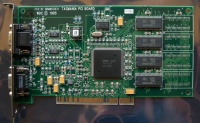Paradise Tasmania 3D
A very early 3D accelerator based on the Yamaha YGV612 Rendering Polygon Accelerator.
The history of the Tasmania 3D starts in the mid-to-late 1980s, with Western Digital adding the Paradise subsidiary to their Multimedia Products Unit in 1986. Paradise produced some of the best VGA cards of the era. The next evolutionary step for many companies was dedicated 3D acceleration.
On Sept 11, 1995, Western Digital and Yamaha announced that they formed a strategic partnership to develop and market 3D products for the PC.
At the time of announcement, 3D acceleration was considered as the next step in real life graphics for the pc, and with the advent of new 3D APIs, and faster interfaces, a number of companies dared to step into this new realm of PC computing.
The 3D game board would be based on the Yamaha YGV612 3D Rendering Polygon Accelerator, and would be marketed under the Paradise brand name.
In the press release, officials from WD and Yamaha explained why they chose to partner up: "Three dimensional graphics is the next technology wave in multimedia," explained Leonard Sharp, who was at the time the vice president of marketing for Western Digital's Multimedia Products Unit. "Yamaha's current 3D technology is the right solution at the right time for consumers to realize the excitement of 3D. “The Yamaha and Western Digital partnership will deliver a new dimension in reality and `twitch response' to PC games that will allow them to rival the best console game machines," said Robert Starr, general manager for sales and marketing for Yamaha Systems Technology Inc. "Our core 3D accelerator expertise combined with Western Digital's board-level knowledge is already attracting OEMs, resellers and game developers."
On Sept 25, 1995, the official announcement came when Western Digital announced its first 3D accelerator, based on the Yamaha YGV612, called the Paradise Tasmania 3D.
The actual Yamaha YGV612 chip was announced Nov 14, 1994, when Yamaha announced two new 3D accelerator chips, the Vram based YGV611 RPA, and a cost reduced, Dram based YGV612 RPA2 that would be released at a later date.
Running at 50Mhz, and produced on a 208-pin QFP package, the YGV612 was one of the first 3D chips to market, and performed polygon rendering, shading, hidden surface removal, texture mapping and Z-buffering. Performance was measured at 300,000 Gouraud-shaded polygons per second and Z-buffering and 150,000 shaded/texture mapped polygons/sec.
The highest resolution supported in 3D was 640 x 480 with 65k colours and supported a maximum of 4Mb Dram.
WD tried to give their first 3D card an edge over the soon to be released competing products by keeping the costs low while still satisfying the consumer’s desire for 3D performance.
At $250, the Tasmania 3D gaming board gave software developers a quick path to porting their 3D games while maintaining compatibility with any VGA board, by using a 9 pin loopback cable, similar to the later released Voodoo Graphics.
The Tasmania controlled the switching from 2D acceleration to 3D acceleration using an on-board analogue MUX. This back-end circuitry takes in the analogue data from the VGA board via a loop-back cable and either routes it directly to the display or switches to the 3D engine.
At the time, 2D graphics cards were still vastly superior to the integrated 2D/3D solutions, so combining 3D acceleration with any 2D board that a consumer already had was a logical move, and also cut down the cost considerably.
The first boards came with a PCI interface, though Western Digital did plan to offer a VL-Bus based board.
The company chose to use the more common polygon rendering approach of the Yamaha chip, rather than employ an alternative rendering technique, such as the curved surfaces (quadratic texture mapping) used in the NV1, produced by their competitor NVidia.
On Sept 27, 1995, only two days after the Tasmania 3D was announced, Western Digital announced that they sold their Multimedia Products Unit to Phillips, which re-established the Paradise name. The sale was finalised on October 31, 1995. The Paradise brand was then owned by the Multimedia PC Group of Philips Semiconductors, which was a Philips Electronics company.
The board began shipping in the same month, but was expected to be widely available in October.
With the upcoming arrival of Direct3D in Windows 95, Yamaha announced support for the new API already back in April, 1995, and subsequently Phillips confirmed that announcement once again with their Tasmania card on April 10, 1996.
The card supported games written for DOS, Windows 3.1 and Windows 95 and was backed up by the major API's at the time, namely RenderWare, BRender and RenderMorphics.
Shipping with Tasmania 3D were two popular PC games: FX Fighter by GT Entertainment, and Domark ‘s Tank Commander . In addition, for a limited time, Tasmania 3D customers could register with Philips to receive three more games from Mindscape: SU-27 Flanker, CyberSpeed and Air Power.
The card was discontinued August 1996, and Direct3D drivers were never released. (More sources needed on D3D drivers and date discontinued)
